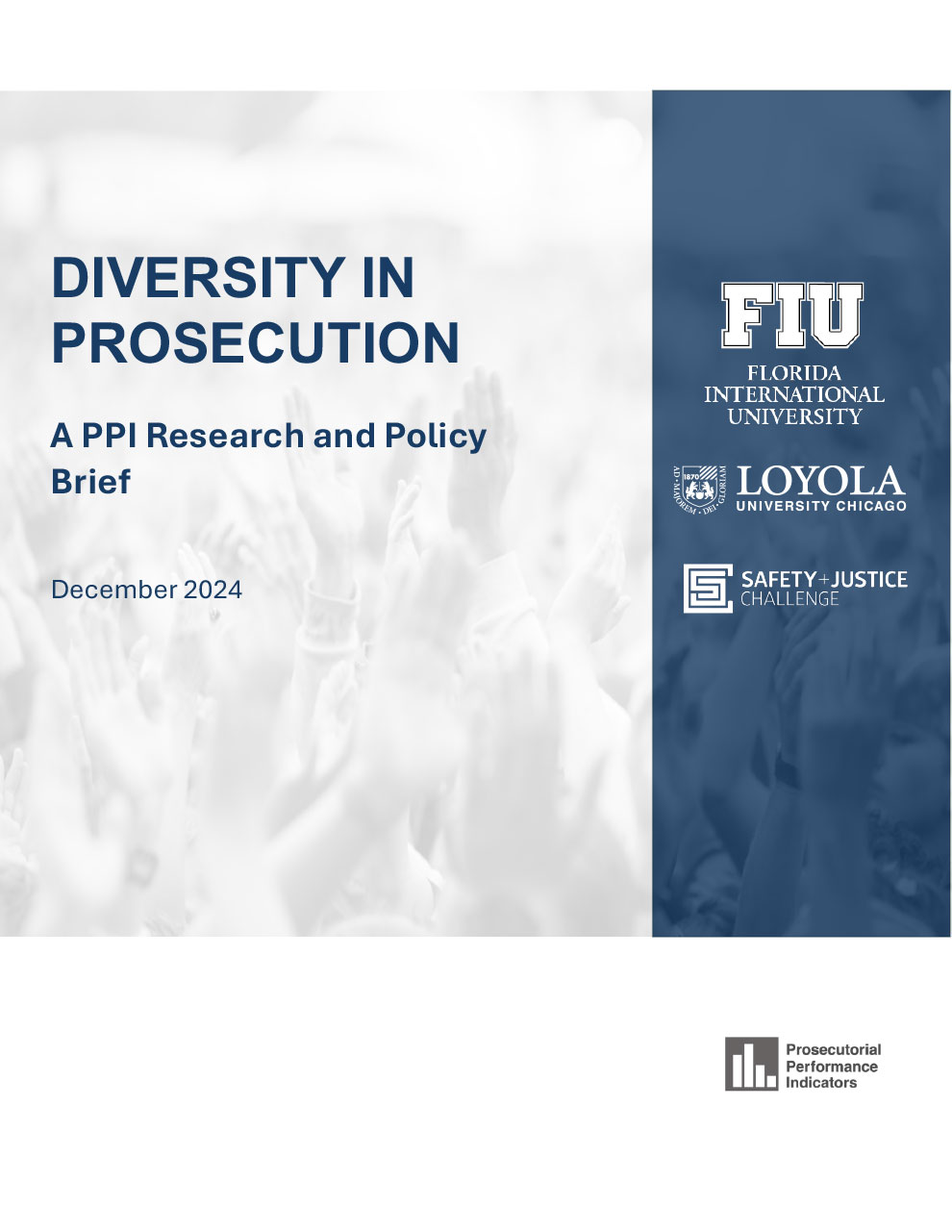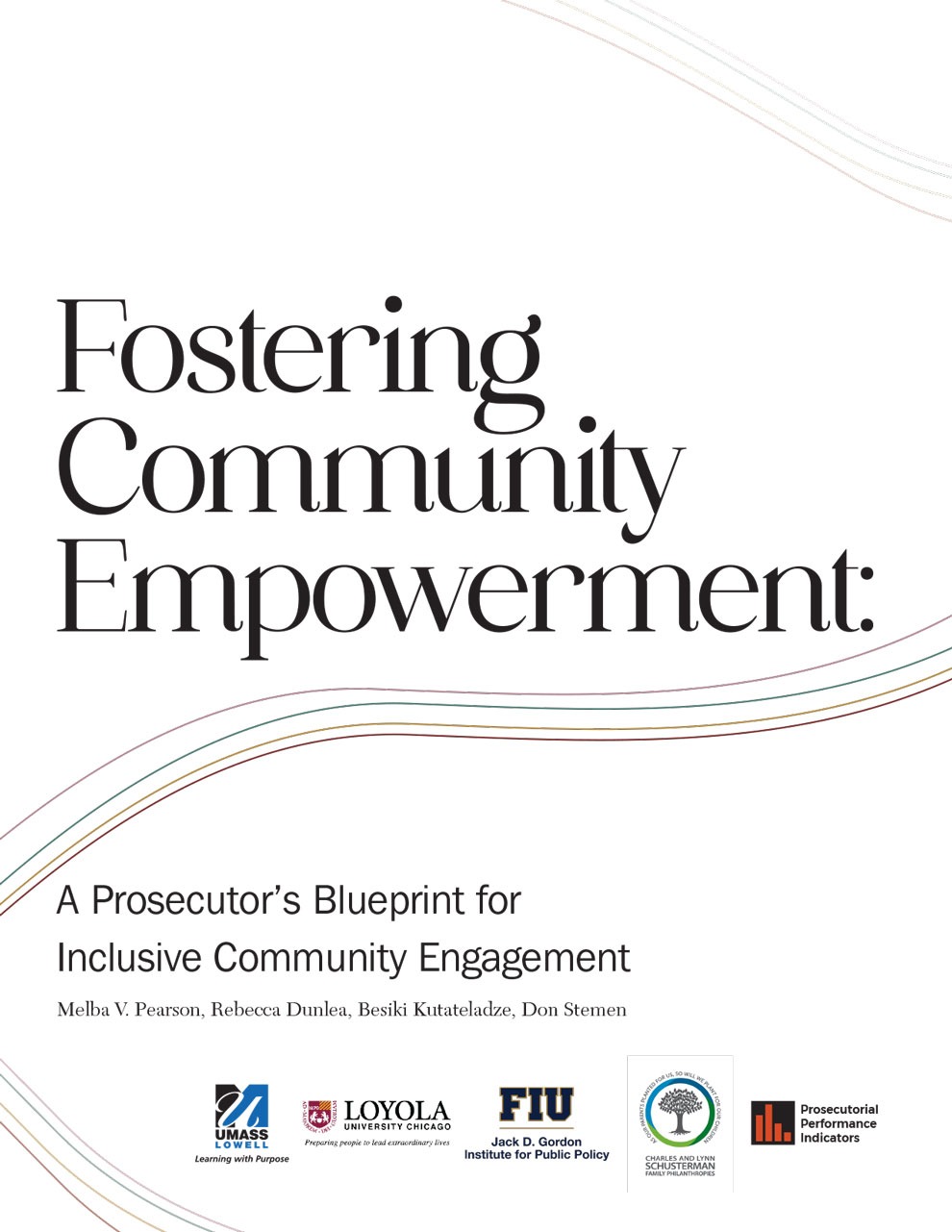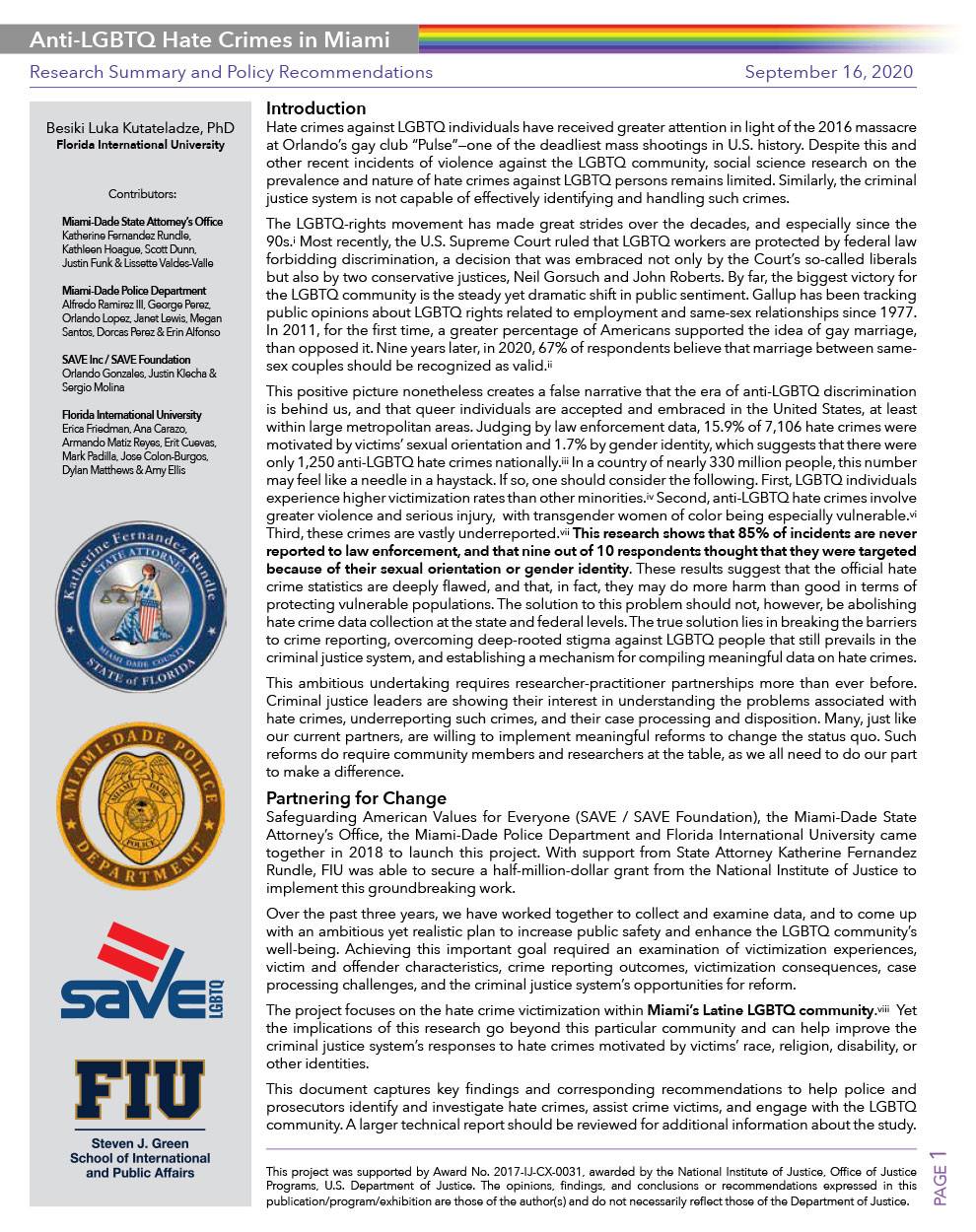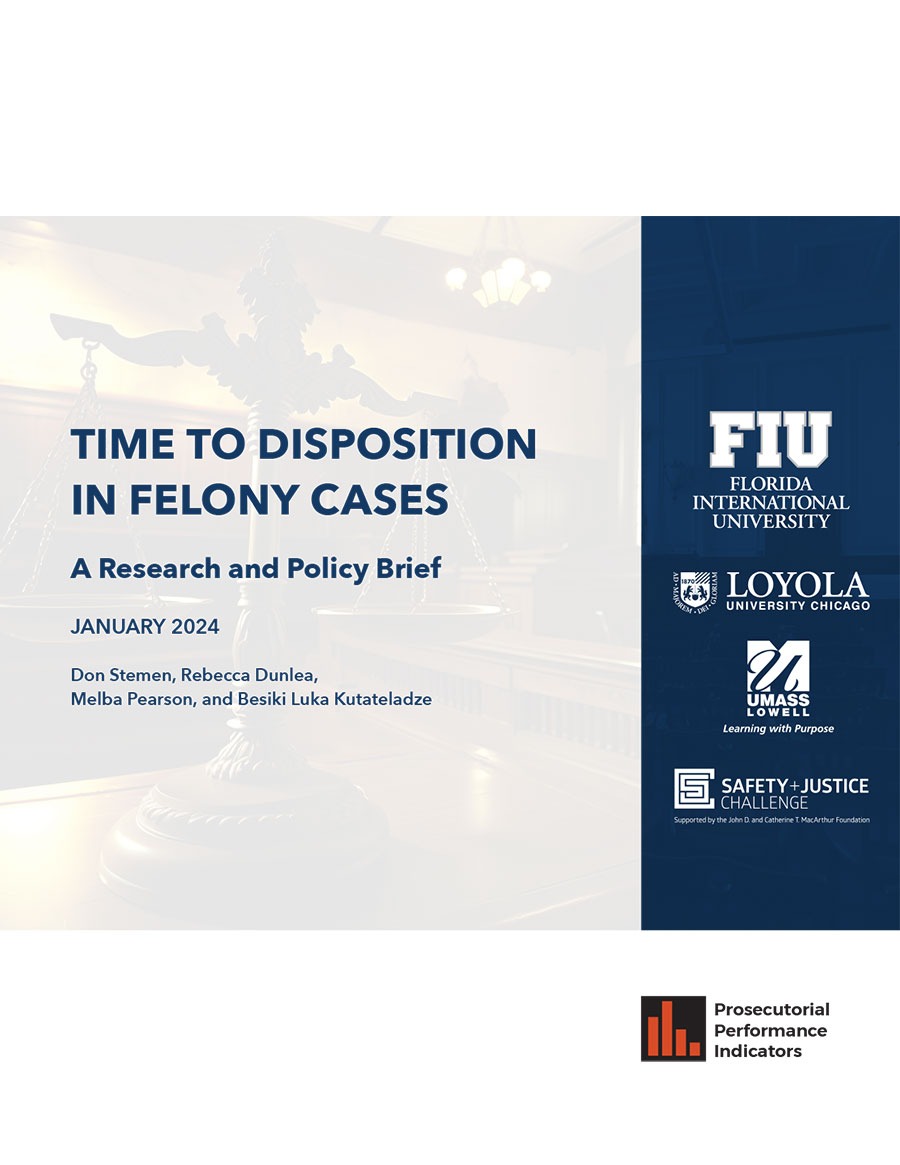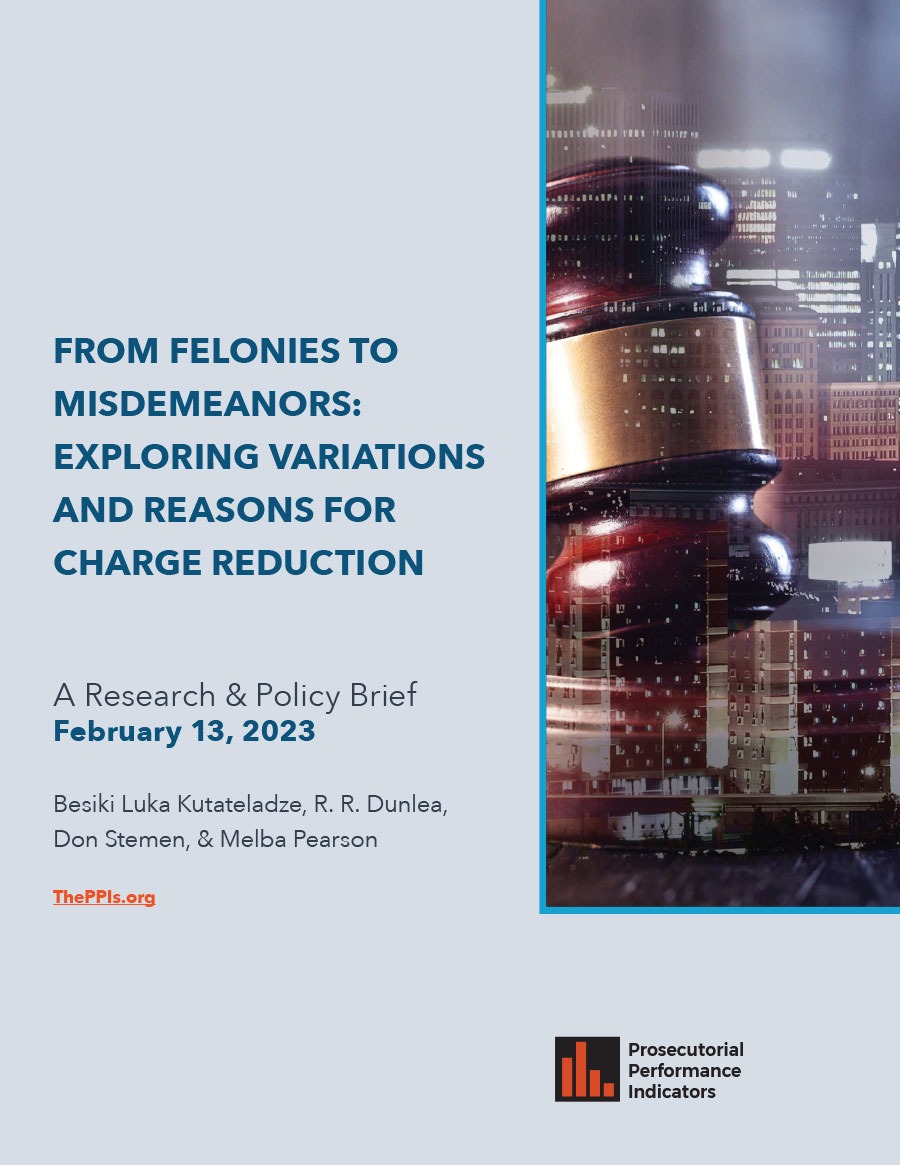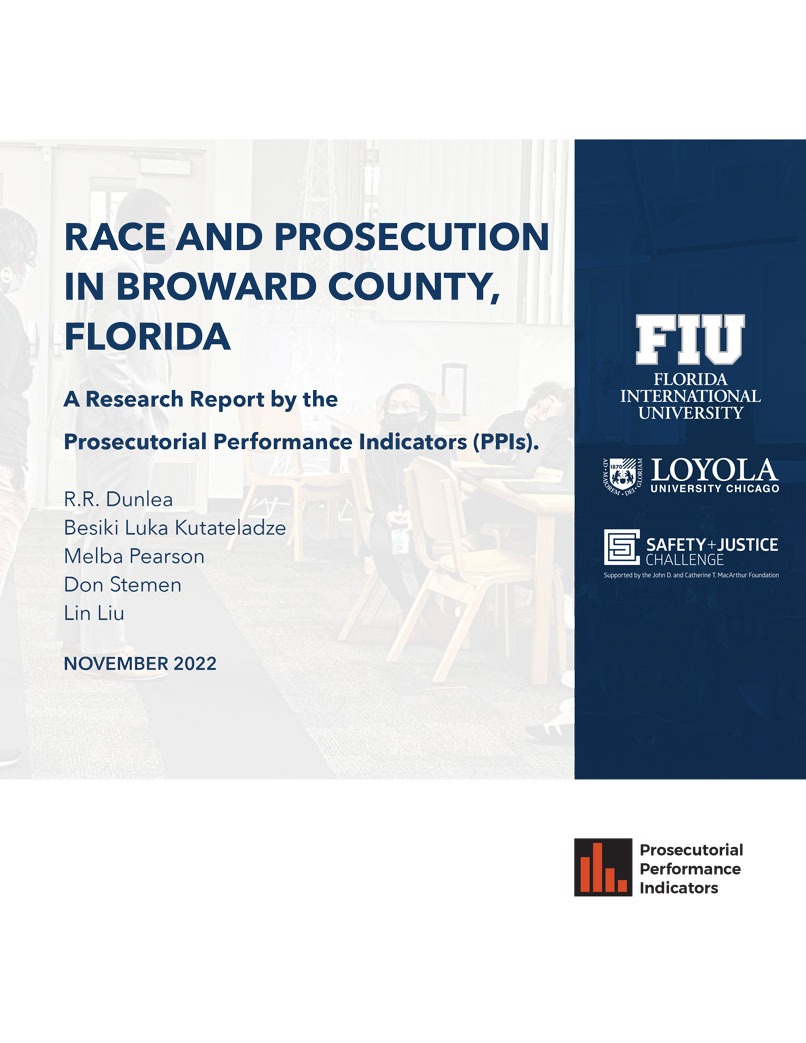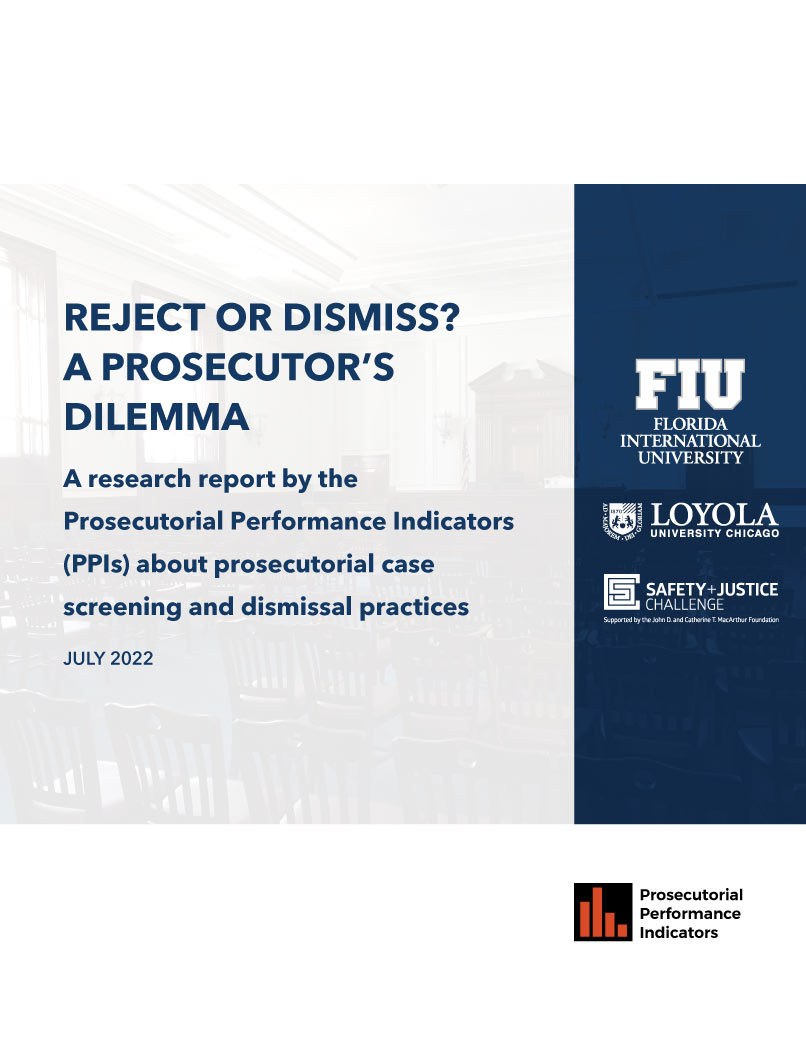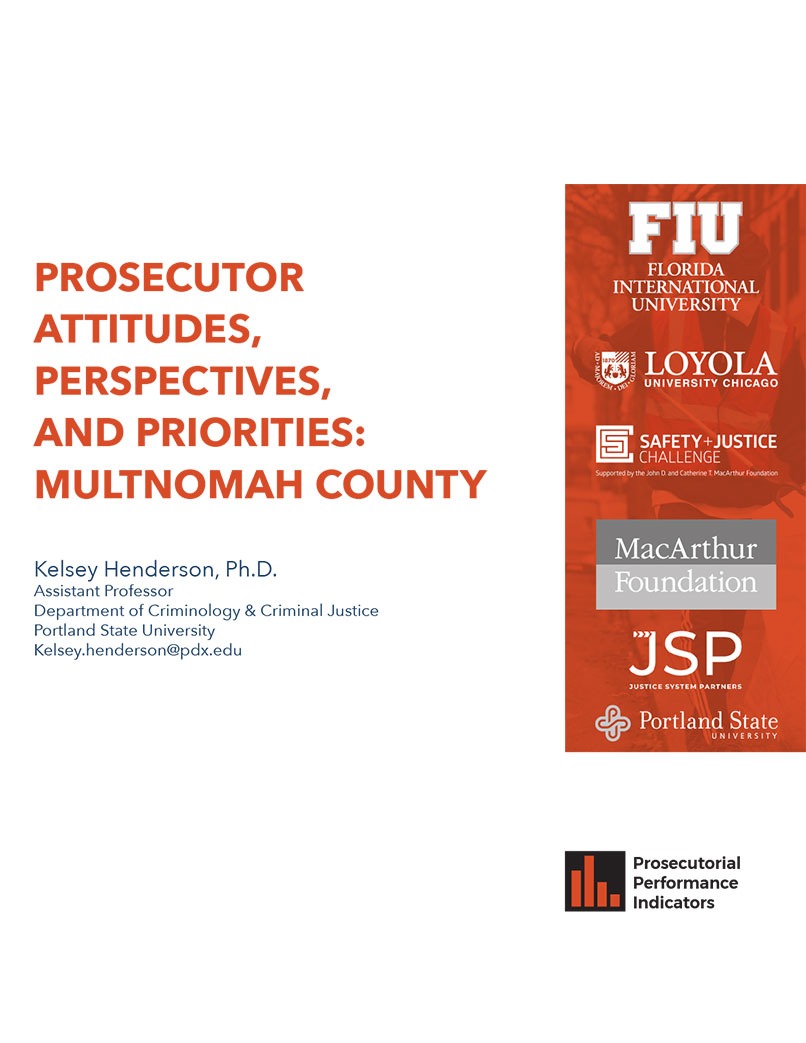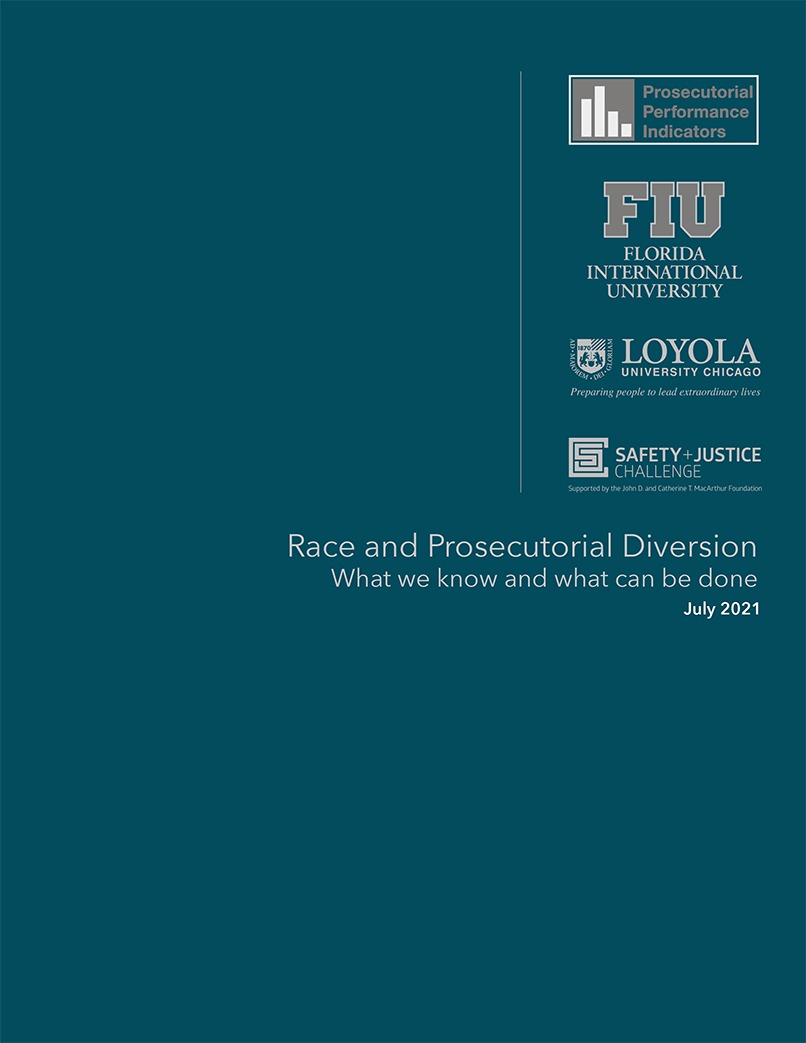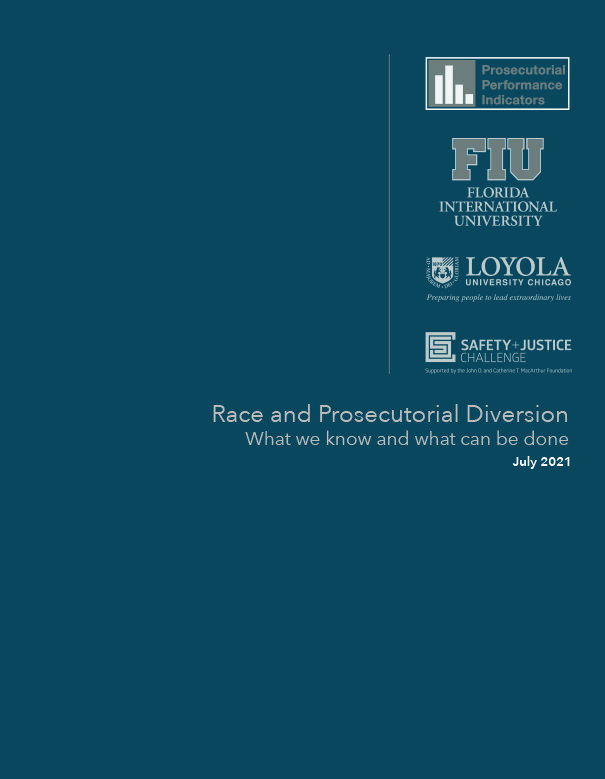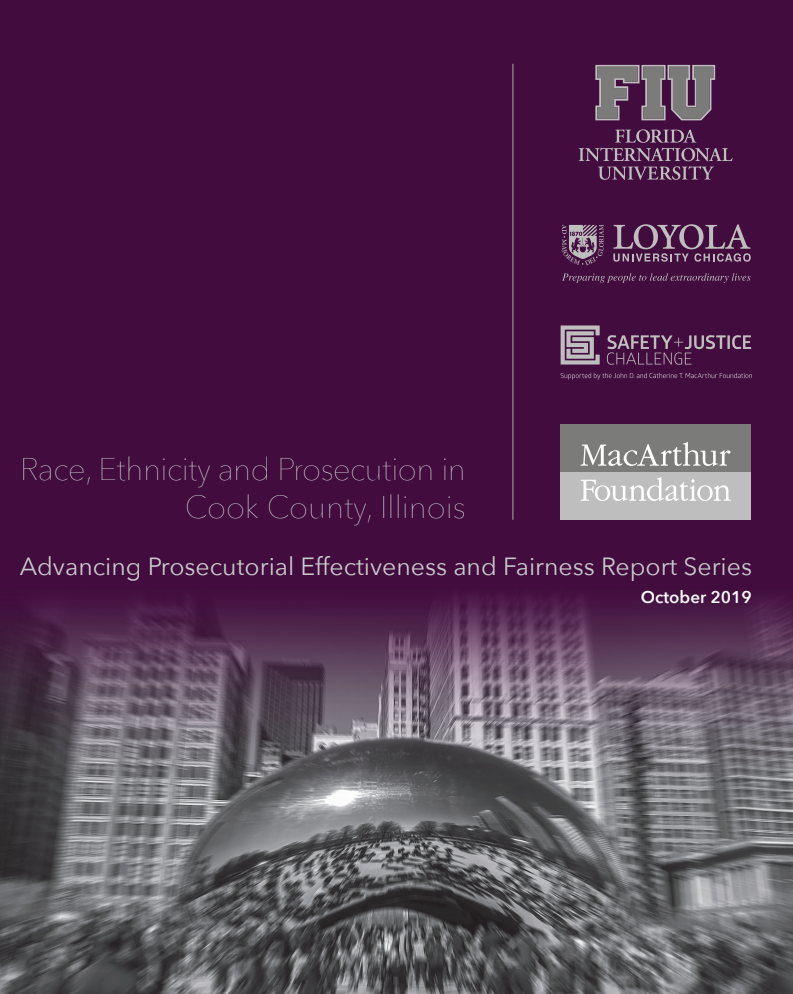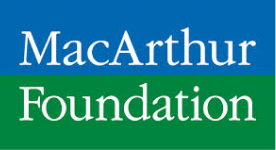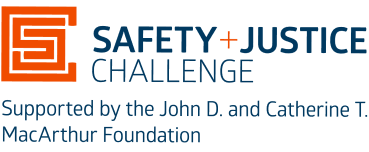Prosecutorial Performance Indicators
A suite of modern indicators for prosecutors committed to measuring effectiveness, efficiency & fairness
The Prosecutorial Performance Indicators
- Office management tool
- Performance measurement tool
- Transparency and community engagement tool
With a menu of 55 indicators, PPIs measure performance toward three goals: Capacity & Efficiency, Community Safety & Well-being, and Fairness & Justice. This website presents the indicators, guides, training materials, and sample data from partner offices to illustrate how the PPIs work in diverse jurisdictions.
Prosecutorial Performance Indicators are:
Impact Oriented
Comprehensive
Objective
Responsive
Data Informed
Free
Capacity & Efficiency
Community Safety & Well-Being
Fairness & Justice
Organizational & Staff Capacity
1.1 Office felony and misdemeanor caseloads
1.2 Felony caseload distribution
1.3 Leadership and line prosecutor diversity
1.4 Staff retention rate
1.5 Clerical and paralegal capacity
1.6 Data and analytic capacity
Addressing Serious Crime
4.1 Violent crime prevention
4.2 Acquittal for violent crimes
4.3 Violent recidivism
4.4 Felony recidivism of diversioners
4.5 Escalation in offending
4.6 Treating serious crime the same across neighborhoods
4.7 Addressing the opioid epidemic
Racial & Ethnic Differences
7.1 Victimization of racial/ethnic minorities
7.2 Case dismissal by victim race/ethnicity
7.3 Case filing by defendant race/ethnicity
7.4 Pretrial detention by defendant race/ethnicity
7.5 Diversion by defendant race/ethnicity
7.6 Charging and plea offers by defendant race/ethnicity
Time & Resource Prioritization
2.1 Ability to identify dismissible cases at filing
2.2 Strategic case rejections at filing and dismissal
2.3 Prioritizing cases with the greatest public safety returns
2.4 Reserving incarceration for serious offenders
2.5 Accurate diversion decisions and placements
Protecting & Serving Victims
5.1 Victim support outreach
5.2 Speedy contact with victims
5.3 Avoiding victim coercion
5.4 Addressing violent victimization of children
5.5 Addressing victimization of the poor
5.6 Addressing sexual assault victimization
Minimizing Unnecessary Punitiveness
8.1 Avoiding unnecessary felony charges at filing
8.2 Diversion as an alternative to incarceration
8.3 Reducing reliance on pretrial detention
8.4 Avoiding felony incarceration when possible
8.5 Incarceration triggered by pretrial detention of the poor
8.6 Discretion over guidelines to avoid excessive penalties
8.7 Disproportionate punishment for the poor
Timeliness of Case Processing
3.1 Time to felony disposition
3.2 Efficient filing decisions for cases with pretrial detainees
3.3 Time to disposition for pretrial detainees
3.4 Conforming to ABA disposition time standards
3.5 Minimizing delays in case processing by limiting continuances
3.6 Dismissal timeliness
Community Outreach & Engagement
6.1 Accessibility of prosecutor’s office
6.2 Expanded crime reporting opportunities
6.3 Engagement with economically diverse communities
6.4 Prosecutorial participation in community events
6.5 Witness cooperation
6.6 Responsiveness to public records requests
Prosecutorial Ethics & Integrity
9.1 Procedural and ethics violations
9.2 Dedication to conviction integrity
9.3 Commitment to law enforcement accountability
9.4 Charging integrity
9.5 Discovery compliance
Capacity & Efficiency
Organizational & Staff Capacity
1.1 Office felony and misdemeanor caseloads
1.2 Felony caseload distribution
1.3 Leadership and line prosecutor diversity
1.4 Staff retention rate
1.5 Clerical and paralegal capacity
1.6 Data and analytic capacity
Time & Resources Prioritization
2.1 Ability to identify dismissible cases at filing
2.2 Strategic case rejections at filing and dismissal
2.3 Prioritizing cases with the greatest public
2.4 Safety returns
2.5 Reserving incarceration for serious offenders
2.6 Accurate diversion decisions and placements
Timeliness of Case Processing
3.1 Time to felony disposition
3.2 Efficient filing decisions for cases with pretrial detainees
3.3 Time to disposition for pretrial detainees
3.4 Conforming to ABA disposition time standards
3.5 Minimizing delays in case processing by limiting continuances
3.6 Dismissal timeliness
Community Safety & Well-Being
Addressing Serious Crime
4.1 Violent Crime prevention
4.2 Acquittal for violent crimes
4.3 Violent recidivism
4.4 Felony recidivism of diversioners
4.5 Escalation in offending
4.6 Treating serious crime the same across
neighborhoods
4.7 Addressing the opioid epidemic
Protecting & Serving Victims
5.1 Victim support outreach
5.2 Speedy contact with victims
5.3 Avoiding victim coercion
5.4 Addressing violent victimization of children
5.5 Addressing victimization of the poor
5.6 Addressing sexual assault victimization
Community Outreach & Engagement
6.1 Accessibility of prosecutor’s office
6.2 Expanded crime reporting opportunities
6.3 Engagement with economically diverse
communities
6.4 Prosecutorial participation in community events
6.5 Witness cooperation
6.6 Responsiveness to public records requests
Fairness & Justice
Racial & Ethnic Differences
7.1 Victimization of racial/ethnic minorities
7.2 Case dismissal by victim race/ethnicity
7.3 Case filing by defendant race/ethnicity
7.4 Pretrial detention by defendant
race/ethnicity
7.5 Diversion by defendant race/ethnicity
7.6 Charging and plea offer differences by defendant race/ethnicity
Minimizing Unnecessary Punitiveness
8.1 Avoiding unnecessary felony charges at filing
8.2 Diversion as an alternative to incarceration
8.3 Reducing reliance on pretrial detention
8.4 Avoiding felony incarceration when possible
8.5 Incarceration triggered by pretrial detention
of the poor
8.6 Discretion over guidelines to avoid excessive
penalties
8.7 Disproportionate Punishment for the Poor
Prosecutorial Ethics & Integrity
9.1 Procedural and ethics violations
9.2 Dedication to conviction integrity
9.3 Commitment to law enforcement accountability
9.4 Charging integrity
9.5 Discovery compliance
News
Publications
Diversity in Prosecution
Foster Community Empowerment
FIU Hate Crimes Research
Time to Disposition in Felony Cases
From Felonies to Misdemeanors: Exploring Variations and Reason for Charge Reduction
Race and Prosecution in Broward County, Florida
Reject or Dismiss? A Prosecutor’s Dilemma
Prosecutor, Attitudes, Perspectives, and Priorities: Multnomah County
Race and Prosecutorial Diversion
Prosecutorial Performance Indicators Implementation Guide
Race, Ethnicity & Prosecution in Cook County, Illinois
Race, Ethnicity & Prosecution in Milwaukee County, Wisconsin
Race, Ethnicity & Prosecution in Clay, Duval & Nassau Counties, Florida
Race, Ethnicity & Prosecution in Hillsborough County, Florida
Prosecutorial Attitudes, Perspectives, & Priorities-Insights from the Inside
Publications
Partner Offices
Pilot Sites
Jacksonville, FL
Office of the State Attorney, 4th Judicial Circuit
- Serving Clay, Duval, and Nassau Counties, 1.2 million residents
- Melissa Nelson, State Attorney since 2017
- Office size: 106 attorneys and ~35,000 cases filed annually
Tampa, FL
Office of the State Attorney, 13th Judicial Circuit
- Serving Hillsborough County, 1.4 million residents
- Andrew Warren, State Attorney since 2017
- Office size: 130 attorneys and ~27,000 cases filed annually
Milwaukee, WI
Milwaukee County District Attorney’s Office
- Serving Milwaukee County, 950,000 residents
- John Chisholm, District Attorney since 2007
- Office size: 130 attorneys and ~10,000 cases filed annually
Chicago, IL
Cook County State’s Attorney’s Office
- Serving Cook County, 5.2 million residents
- Kim Foxx, State’s Attorney since 2016
- Office size: 700 attorneys and ~300,000 cases filed annually
Partner Offices
Current Implementation & Network Sites
Santa Clara, CA
Santa Clara District Attorney’s Office
- 1.924 million residents
- Jeff Rosen, District Attorney since 2011
- Office size: ~190 prosecutors
Ninth Circuit Solicitor’s Office
- Serving Charleston & Berkeley Counties, 639,000 residents
- Scarlett A. Wilson, Solicitor since 2007
- Office size: 50 attorneys and ~12,000 cases filed annually
- Disparity and Prosecution Report
Broward County, FL
Office of the State Attorney, 17th Judicial Circuit
- Serving Broward County, ~2 million residents
- Harold Pryor, State Attorney since 2021
- Office size: 213 attorneys, 45,000 cases filed annually
Multnomah County, OR
Multnomah County District Attorney’s Office
- Serving metropolitan Portland area, ~813,000 residents
- Mike Schmidt, District Attorney since 2021
- Office size: 70 attorneys, ~11,000 cases filed annually
- Local research partner: Portland State University, Justice System Partners
- Multnomah County District Attorney’s Office PPI Dashboard (Click Here)
Orange/Osceola County, FL
Office of the State Attorney, 9th Judicial Circuit
- Serving Orange/Osceola Counties (metro Orlando area), 1.4 million residents
- Monique Worrell, State Attorney since 2021
- Office Size: 155 attorneys and ~25,000 cases filed annually
Lake County, IL
Lake County State's Attorney's Office
-
Serving Lake County, 714,000 residents
-
Eric Rinehart, State’s Attorney since December 2020
- Office size: 75 attorneys, ~9,000 cases filed annually
- Lake County Dashboard
Montgomery County, MD
Montgomery County State's Attorney's Office
- Serving Montgomery County, 1.1 million residents
- John McCarthy, State’s Attorney since 2006
- Office Size: 70 attorneys, ~12,000 cases filed annually
- Local research partner: University of Maryland
New York, NY
New York District Attorney’s Office
- 1.62 million residents
- Alvin Bragg, District Attorney since 2021
- Office size: 500 prosecutors
New Orleans, LA
New Orleans Parish District Attorney's Office
- Serving New Orleans Parish, 390,000 residents
- Jason Rogers Williams, District Attorney since 2021
- Office Size: 65 attorneys
- Local research partner: AH Datalytics
- New Orleans Parish Dashboard
Frederick State’s Attorney’s Office
- Serving Frederick County, 293,000 residents
- J. Charles “Charlie” Smith III, State’s Attorney since 2006
- Office Size: 32 attorneys, ~4,000 cases filed annually
- Frederick County Dashboard
Colorado
Colorado Prosecutorial Dashboards
- Learn More: Colorado Prosecutorial Dashboards
- 1st Judicial District (Gilpin, Jefferson)
- 2nd Judicial District (Denver)
- 5th Judicial District (Clear Creek, Eagle, Lake, Summit)
- 6th Judicial District (Archuleta, La Plata, San Juan)
- 7th Judicial District (Delta, Gunnison, Hinsdale, Montrose, Ouray, San Miguel)
- 8th Judicial District (Jackson, Larimer)
- 18th Judicial District (Arapahoe, Douglas, Elbert, Lincoln)
Baltimore City
Baltimore City
- Serving Baltimore City, 565,000 residents
- Ivan Bates, State’s Attorney since 2023
- Office Size: 200 attorneys, ~23,000 cases filed annually
- Local research partner: University of Maryland
The Team

Besiki Luka Kutateladze
Florida International University
Don Stemen
Loyola University Chicago
Rebecca Dunlea
University of Massachusetts Lowell

Melba Pearson
Florida International University
Branden DuPont
Loyola University of Chicago
David Olson
Loyola University Chicago

Rachel Silverthorn
Florida International University

Eduardo Mendoza Montoya
Florida International University

Tierra Fulwood
Florida International University

Michael Hall
MediumFour












